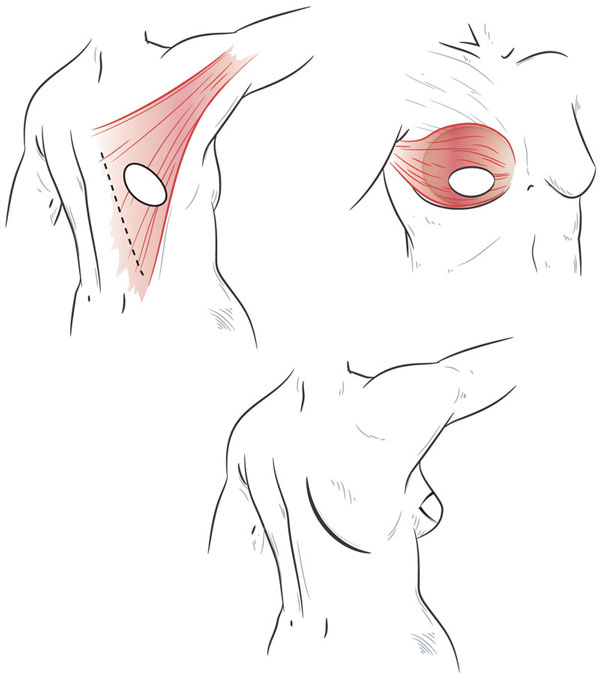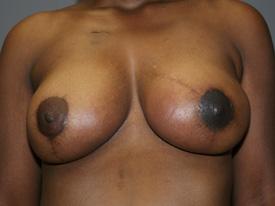Latissimus Dorsi Flap Breast Reconstruction
The latissimus dorsi flap brings healthy living tissue from a woman’s back to reconstruct the breast. In most cases, it is paired with an implant to achieve the desired size and shape.

What is the latissimus Dorsi Flap Procedure?
A latissimus dorsi flap brings skin, fat, and muscle from the back to recreate the breast. Most women do not have sufficient back tissue to create a breast, so this approach often requires the placement of an implant as well. In fact, one of the most common scenarios for a latissimus dorsi flap is a failed implant reconstruction that requires the introduction of healthy tissue to heal. In contrast to a free flap such as a DIEP, the latissimus dorsi flap is tunneled through the axilla to reach the chest and does not require new vascular connections. For that reason, flap failure is very rare.

Benefits of Latissimus Dorsi Flap Breast Reconstruction
- Replaces damaged breast skin or skin removed with the mastectomy
- Promotes healing and a successful reconstruction by introducing healthy living tissue
- When used with an implant, coverage with live tissue can create a more natural appearance
- Requires a shorter hospitalization and recovery than other autologous reconstructions (eg. DIEP)
- Avoids the complexity and risks of reconstructive methods that require microvascular connections
Who is a Candidate?
Women who favor breast reconstruction with their own tissues but have insufficient abdominal tissue for a DIEP flap may be candidates for an alternative donor site, such as the back. Because the back tends to be slimmer, the latissimus flap by itself can be used to reconstruct only a smaller breast. In the vast majority of cases, the latissimus flap is paired with an implant to achieve the desired size and shape.
In some cases, reconstructing the breast with living tissue is beneficial or even necessary. The latissimus flap can be used to address certain complications following an implant-based reconstruction, such as skin damage or dense scarring around the implant. By introducing healthy tissue from the back, the implant reconstruction can be salvaged. The latissimus flap can also be used at the initial operation (following the mastectomy) if the breast skin is already damaged, for instance from prior radiation therapy.
During your consultation, share your goals and priorities with Dr. Davison and Dr. Pinell. This will help them identify the best method of reconstruction for you.

Latissimus Flap Reconstruction: What to Expect
- The first stage of reconstruction can usually be performed at the time of the mastectomy.
- In most cases, the latissimus flap is transferred to the breast and a tissue expander placed beneath it. Two incisions are required, one on the breast and one on the back.
- A one-sided latissimus flap operation takes approximately 2 to 3 hours.
- Patients generally stay in the hospital for 2 or 3 days, but a complete recovery may take 4 weeks or more.
- If a tissue expander was placed at the initial operation, a series of expansions are performed in the office over the course of weeks or months. When the target size is reached, a 2nd operation is planned to exchange the tissue expander for an implant.
- Subsequent operations are often planned to refine the reconstructed breast, create a nipple, or to balance the opposite side.
Frequently Asked Questions
-
Can a latissimus flap reconstruction be performed at the time of mastectomy?
Yes. Immediate breast reconstruction is generally safe, produces the best aesthetic result, and is beneficial to coping with the loss of a breast.
-
Does a latissimus flap reconstruction always require placement of an implant?
No, but most women do not have sufficient back fat to recreate a large breast. However, if a woman desires a small breast, it is usually possible to perform a latissimus flap reconstruction without an implant.
-
What are the risks of latissimus flap breast reconstruction?
- As with any breast reconstruction, there are risks of bleeding, infection, problems of wound healing, and changes in sensation.
- The most common complication that arises on the back is a fluid pocket or seroma. Drains are placed at the time of surgery to prevent this complication.
- Because there are other muscles that act on the shoulder, most women do not experience significant long-term loss of strength or mobility. Nevertheless, someone who is very reliant upon their upper body strength, such as a rock climber or kayaker, may favor a different type of breast reconstruction.
- The latissimus flap requires an occasionally lengthy scar on the back, some or all of which can be concealed under a bra. Some patients have a noticeable depression in the back where the muscle was harvested.
- If a tissue expander or implant is used, there are risks of scarring around the device (capsular contracture), implant malposition, or rarely, implant rupture.
-
How long does a latissimus flap operation take, and how long is a patient usually in the hospital?
A unilateral (one-sided) latissimus flap reconstruction takes 2 to 3 hours, and patients are typically hospitalized for 2 or 3 days.
-
What is the recovery time following a latissimus flap operation?
Patients should be out of bed the evening of surgery and then gradually increase their activities from that point forward. While most women have resumed a modified daily routine by 2 to 3 weeks, a full recovery can take 4 to 6 weeks.
-
Are subsequent surgeries needed after a latissimus flap?
If a tissue expander is placed under the flap at the initial operation, a series of expansions will be performed in the office to achieve the desired size. Depending on the ultimate goal, this process can take weeks or months. Once expansion is completed, a second operation is planned to exchange the tissue expander for a permanent implant.
Women will frequently undergo revision procedures to refine or enhance the appearance of the reconstructed breast. Nipple reconstruction and balancing operations on the opposite breast can be performed at that time as well.
-
Does insurance cover latissimus flap breast reconstruction?
Yes. All methods of breast reconstruction after a mastectomy and balancing procedures to the opposite breast are generally covered by insurance.


